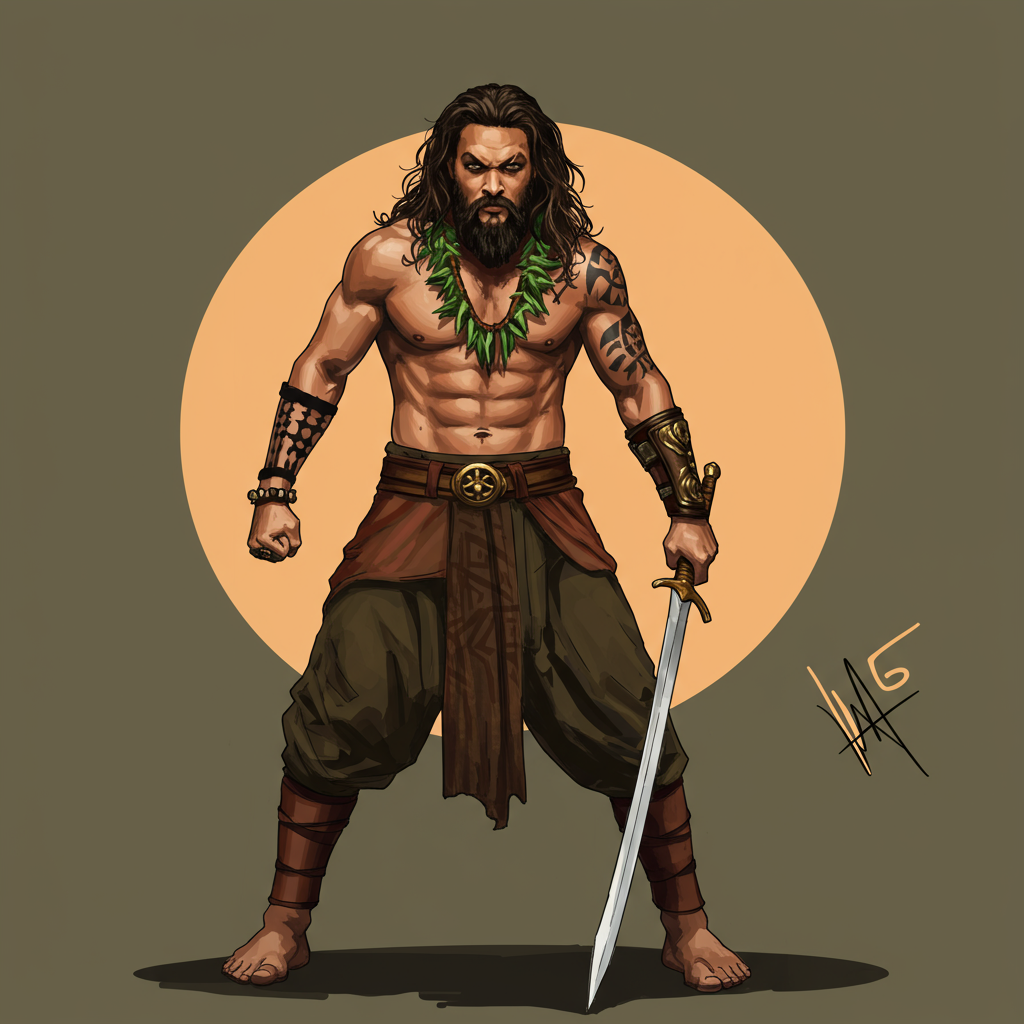Apple TV+ is set to unveil “Chief of War,” a groundbreaking historical drama series that plunges viewers into the tumultuous late 18th century of precolonial Hawai’i. Co-created by and starring Jason Momoa, this ambitious project stands out as a deeply personal and meticulously researched passion endeavor. It centers on the legendary warrior Ka’iana, portrayed by Momoa, and explores the dramatic intersection of the island kingdoms with the transformative arrival of European colonists.
This series offers a unique and vital perspective, becoming the first such large-scale drama to be told authentically by Kanaka Maoli, the Indigenous people of Hawai’i. It promises to be not just entertainment, but an immersive educational journey into a pivotal era rarely depicted with such cultural depth on screen. Prepare to witness a compelling narrative of war, love, and the complex journey towards unification in a visually stunning historical landscape.
Unveiling “Chief of War”: A Deep Dive into Precolonial Hawai’i
“Chief of War” is more than a television series; it’s a cultural touchstone. Premiering on Apple TV+ with new episodes releasing weekly through September 19, 2025, this nine-episode epic chronicles the true historical events surrounding Ka‘iana’s monumental efforts to unify the Pacific islands. This era, preceding significant Western colonization, is rich with conflict, ambition, and profound cultural shifts.
At its heart, the series aims to transcend typical historical narratives. It provides an intimate look at a vibrant society on the cusp of radical change. The decision to tell this story from a Native Hawaiian viewpoint addresses a significant gap in global media, offering audiences an authentic experience unlike the more generalized portrayals often seen.
Jason Momoa’s Vision and Dedication
For Jason Momoa, born in Honolulu with deep Hawaiian heritage, “Chief of War” is a profound return to his roots. This project is a testament to his dedication to respectfully representing his people’s history and culture. He steps away from his celebrated genre roles – from Khal Drogo to Aquaman – to portray a complex historical figure, revealing a new facet of his versatile acting prowess.
Momoa not only stars but also executive produced and co-wrote the series alongside Thomas Paʻa Sibbett. This dual role underscores his commitment, ensuring the narrative remains true to its cultural origins. His personal investment permeates every aspect of the production, making it a truly authentic piece of storytelling.
The Story of Ka’iana: A Warrior’s Contradictions
The narrative introduces us to Ka’iana, a Maui war chief who, seeking peace, has deserted his army. He chooses a quiet life on Kaua’i with his brothers and partners. Yet, like a retired gunslinger in a classic Western, circumstances inevitably pull him back into the maelstrom of conflict. He is called a “chief of contradictions” – a warrior who initially runs from war, but whose destiny is inextricably linked to it.
Momoa’s portrayal of Ka’iana is fittingly Herculean, aligning with contemporary accounts describing the real-life figure’s imposing stature. While he embodies a hero of almost “superhero” capabilities – catching spears or riding a drugged shark – the character is grounded in deep emotional complexity. Ka’iana grapples with familial obligations, matters of the heart, and the constant struggle to have his progressive ideas heard amidst rigid traditions. His journey also involves encounters with foreign technologies, like firearms, and learning English, showcasing the early impacts of external influences on Hawaiian society.
Navigating Island Kingdoms and Shifting Alliances
“Chief of War” masterfully navigates the intricate political landscape of precolonial Hawai’i. The series vividly portrays the distinct island kingdoms of Kaua’i, Hawai’i, Maui, and O’ahu. These islands, initially separated by cunning chiefs and powerful gods, are locked in a cycle of “endless war.” A central prophecy foretells a king who will unite them, bringing an end to the pervasive conflict.
The story highlights the ambitious monarchs and warring factions that define this era. Figures like the formidable King Kahekili (played by Temuera Morrison), who believes he is the prophesied unifier through conquest, and Kamehameha (Kaina Makua), whose inclinations lean towards peace despite commanding a powerful “god of war” artifact, create a rich tapestry of intrigue. Viewers may find themselves needing to take notes to track the complex alliances and rivalries among districts within and across islands.
Beyond the Battlefield: Cultural Authenticity and Social Themes
What truly sets “Chief of War” apart is its unwavering commitment to cultural authenticity and its exploration of pressing social themes. This dedication elevates the series beyond a mere historical account.
A Linguistic and Visual Masterpiece
One of the most remarkable aspects of “Chief of War” is its linguistic immersion. The series is performed almost entirely in the Hawaiian language, a profound testament to Momoa’s commitment to his heritage. This creative choice, requiring English captions, was a challenging yet rewarding endeavor for the predominantly Polynesian cast. Dialogue coaches, known as “kumu,” were on set daily, meticulously ensuring linguistic accuracy, even necessitating re-takes for precise pronunciation.
The visual artistry further enhances this authenticity. Filmed across breathtaking locations in Hawai’i and New Zealand, the series boasts thoughtful design and stunning cinematography. The elaborate, historically accurate costumes – from feathered capes to bone-and-claw necklaces – are faithful recreations of garments seen in museums, contributing significantly to the visual spectacle despite their practical difficulties for the actors.
Confronting Colonialism and Championing Women
“Chief of War” does not shy away from the harsh realities of colonialism. The series explicitly addresses the arrival of European colonists and the devastating impact of white racism and exploitation on Indigenous populations. A poignant moment occurs when a Black character, Tony, befriends Ka’iana and articulates a stark truth: “They do not see you as people,” powerfully underscoring the racial dynamics of the era.
Moreover, the series incorporates what has been described as “anticipatory feminism.” Momoa and Sibbett deliberately integrate strong, multidimensional female characters into a traditionally testosterone-heavy world. Figures like Kupuohi, a former “chiefess of war,” and Heke, who seeks combat training, are given significant roles and offer profound insights. One character wisely observes, “Men train their whole lives to be warriors but they fear being wrong more than they fear death.” The series also includes gay characters, presented naturally and without comment, further reflecting its inclusive and forward-thinking approach to storytelling.
Critical Acclaim and Epic Comparisons
The critical reception for “Chief of War” highlights its unique position in the historical drama landscape. While the pacing can be described as “pokey” or “elegiac” between major events, the action scenes are undeniably impactful, often disturbingly violent. The performances across the board, including those from nonprofessional actors like Kaina Makua, are consistently praised for their excellence.
Comparisons to other epic dramas are inevitable and apt. The subtitled Hawaiian dialogue and themes of ambitious monarchs, warring factions, and encounters with outsiders draw parallels to “Shogun.” Its intricate internal conflicts and power struggles also evoke “Game of Thrones,” a series where Momoa previously excelled. Even the opening sequence, with a prophetic voice setting the stage for a united kingdom, brings to mind the grand lore of “The Lord of the Rings.” The score, crafted by Hans Zimmer and James Everingham, provides a “Hollywood-obvious” yet impactful backdrop. Despite moments of “corniness,” the sheer passion and unique storytelling make “Chief of War” a compelling watch. It is a genuine labor of love that shines through, offering a fresh, educational, and deeply engaging experience.
Frequently Asked Questions
What specific historical period does “Chief of War” cover, and what makes its portrayal unique?
“Chief of War” is set in the late 18th century, a crucial period in precolonial Hawai’i just before the full impact of European colonization. Its portrayal is unique because it is the first major historical drama of its kind told primarily by Kanaka Maoli, the Indigenous people of Hawai’i. This perspective provides an authentic, insider’s view of the island kingdoms, their internal conflicts, and their initial encounters with outsiders, moving beyond typical Western interpretations of the era.
How does “Chief of War” achieve its linguistic and cultural authenticity?
The series achieves linguistic and cultural authenticity through several key decisions. Primarily, it is performed almost entirely in the Hawaiian language, necessitating rigorous training with on-set dialogue coaches known as “kumu” to ensure precise pronunciation. Additionally, the cast is predominantly Polynesian, contributing to the genuine representation. Visually, the production filmed on location in Hawai’i and New Zealand, featuring meticulously recreated, historically accurate costumes that reflect the material culture of the period.
What themes does “Chief of War” explore beyond historical conflict, and why might they resonate with modern audiences?
Beyond historical conflict, “Chief of War” delves into profound themes relevant to contemporary audiences. It explicitly confronts the realities of colonialism and white racism, showing how Indigenous populations were perceived and exploited. The series also champions “anticipatory feminism,” featuring strong, complex female characters who are active agents in the narrative and offer insightful perspectives. The inclusion of gay characters without comment further underscores its progressive approach. These themes of identity, social justice, and female empowerment resonate strongly with modern viewers seeking diverse and thoughtful storytelling.
“Chief of War” offers an unprecedented opportunity to engage with a vital piece of Hawaiian history, told with passion, authenticity, and a contemporary eye for social commentary. It’s an essential watch for anyone interested in epic historical dramas, Indigenous storytelling, or the compelling intersection of culture and conflict. Dive into this rich narrative and discover the untold sagas of the Pacific islands.


